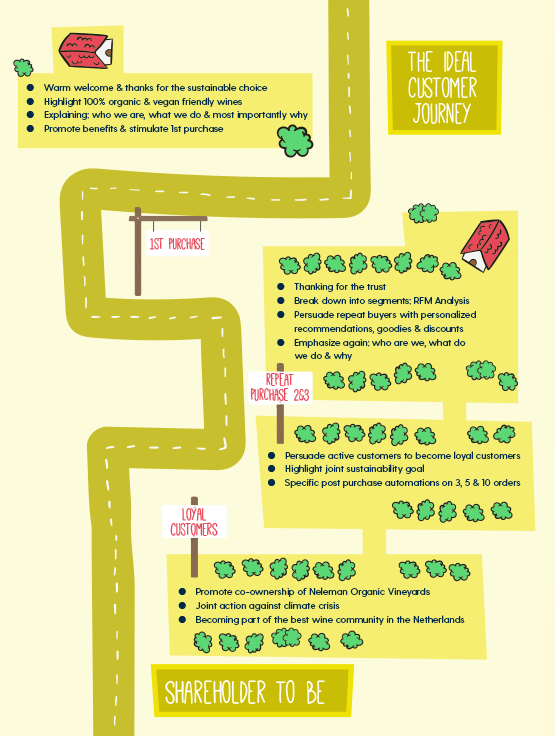Neleman wijnen, a leading producer of organic wines, has experienced impressive growth since its founding in 2014 by Derrick Neleman. The company is committed to sustainability and social responsibility, which is reflected in their motto: “Together we drink the world more beautifully.” These core values form the basis of their marketing strategy, which relies heavily on email marketing automation. In this article, we will discuss how Neleman wijnen have significantly increased their marketing power with the help of a well-thought-out combination of automation strategies.
This article is written by Hendrik Westerhuis, Senior Content Marketeer at Spotler. Spotler is one of the sponsors of the 2024 Email Marketing Automation Summit. Have you got your tickets yet? Get them at: shop.emas.nu.
The power of CDP and email marketing automation
The use of a Customer Data Platform (CDP) that drives email marketing automation, plays a crucial role in the success of Neleman Wijnen. Email is accountable for about 60% of their total turnover. Neleman uses more than twenty well-coordinated automations and commercial newsletters to convert prospects and nurture customers. This approach ensures that customers receive relevant and personalized content at every point in their customer journey.
Collaboration with mailmeisters and Spotler
Neleman works closely with digital agency mailmeisters to set up and realise the various automations. The collected customer data is managed in the Customer Data Platform (CDP) Spotler Activate, which then triggers the right email flows in Spotler Mail+. This collaboration ensures that Neleman wijnen has set up the right automations at all important touchpoints.
The Customer Matrix
The Customer Matrix of Neleman wijnen is a detailed plan with more than ten important touchpoints, on which various automatic campaigns have been set up. This keeps a customer or prospect in the picture, no matter where they are in the buyer or customer journey. Here are some key automations in the matrix:
- Onboarding new customers: New customers are welcomed and taken into the world of Neleman wijnen, including the benefits of their organic products.
- Increase customer engagement: Customers are incentivised to buy more often through personalised recommendations and special offers.
- Personalised product recommendations: Based on previous purchases, customers get recommendations that align with their preferences.
- Lead generation of valuable customers: Generating leads through look-a-like models, who seek similar profiles to attract new customers.
- Upsell active customers: Active customers get offers that entice them to buy more and more often.
- Preventing churn: Customers who are at risk of dropping out are reactivated with targeted campaigns.
- Funnel recovery: Customers who do not complete their purchase process are encouraged to complete their order.
- Personalising content: Each communication is tailored to the individual customer to increase relevance and engagement.

Defining customer groups
Neleman wijnen uses an RFM (Recency, Frequency, Monetary Value) analysis from their CDP to divide customers into different groups. This format helps create targeted campaigns that cater to the specific needs and behaviours of each customer group. Examples of these customer groups are:
- Prospects (unknown visitor/no order placed yet)
- New customers (1st order < 3 months)
- Green customers (1st, 2nd, or 3rd order < 12 months)
- Potential Loyal customers (active customers with 3 to 4 orders < 12 months)
- Loyal customers (active customers with 5-10 orders)
- Top customers (active customers with 10 orders or more)
- Risk Churn customers (no order last 6-12 months)
- Valuable Inactive customers (no order last 12-36 months with initial high order value)
- Inactive customers 12-36 months (no order last 12-36 months with low order value/one-time order)
- Shareholders (to be)
For each customer group, specific campaigns are set up with relevant content and dynamic product blocks, tailored to the customer’s preferences and behaviours.
Campaigns that connect with the different customer groups
The customer groups are based on an RFM analysis, which is a well-known method in eCommerce marketing to classify customers. This classification is done by answering the following three questions:
- How recently did a customer make a purchase?
- How frequently does a customer buy?
- What is the value of the customer’s purchases?
The Customer Data Platform Spotler Activate can define customer groups for you based on such an RFM analysis. The values that the CDP uses for this can be adjusted manually. In this way, the proposed customer groups can be easily adapted to the specific circumstances of – in this case – Neleman wijnen.
Of course, mailmeisters first determined the right strategy for the definition of the RFM groups. After that, different personal campaigns were set up for each group. The emails of the various campaigns work with relevant content and dynamic product blocks, so that each email always meets the wishes of the customer. But also, in these product blocks there is variation with different recommendation sets. In this way, mailmeisters can show the right recommendations for Neleman per target group and per campaign. From the most popular wines to similar in taste and from favourite grape variety to “recommended for you” and much more. Separate flows have now been set up for the most important customer groups.
To name a few examples:
- For new customers, the aim is to make a second (and third) purchase as soon as possible, because Mailmeisters has seen that Neleman customers with multiple orders in the first half of the year appear to be more loyal customers.
- The “About to Lose” customer group is seduced with great offers and short-term campaigns, with the aim of reactivating customers and encouraging them to place a new order.
- For the “Promising” and “Champions” customer group, Neleman prefers to emphasize the relationship and Mailmeisters ensures that this group receives relevant content specifically tailored to behaviour.
Connection to active and inactive customers
Neleman’s automations are aimed at engaging and converting both active and inactive customers. Automatic email campaigns are triggered by actions or lack of action from different customer groups. The goal is to motivate customers to reach the next destination in their customer journey.
The ideal customer journey
The ultimate goal of Neleman wijnen is to turn prospects into loyal customers and ultimately shareholders. This journey starts with a first acquaintance and continues to engage customers in the world of Neleman wines through welcome offers, personal stories and highlighting the benefits of organic and sustainable viticulture. The ideal customer journey looks like this:
- Welcome potential customers with a nice welcome offer.
- Bringing new customers into the story behind Neleman. Split into segments: newsletter subscription, direct customers or buyers via retailer.
- Entice active customers to make a repeat purchase.
- Upsell from 1st to 2nd order and 2nd to 3rd order.
- Attention to top customers.
- Specific flows for shareholders (to be).
Birthday campaign
A good example of a campaign that is not directly driven by specific customer behaviour, but is dependent on customer segmentation, is the birthday campaign. Loyal customers receive an extra reward for thanking them for their trust, while new customers receive a warm welcome. The flow consists of three consecutive mailings around the customer’s birthday, with the aim of earning a purchase.
From prospect to customer
Neleman wijnen uses various methods to entice visitors to their website to sign up for the newsletter. This is done through a regular newsletter pop-up, a message bar or personal wine advice from Derrick Neleman. This approach results in an average conversion uplift of 25%, with peaks of up to 56%.
From customer to loyal customer
The ideal customer journey at Neleman consists of several phases:
- Welcome potential customers with a nice welcome offer.
- Bringing new customers into the story behind Neleman, segmented into newsletter subscribers, direct customers or buyers via retailer.
- Entice active customers to make a repeat purchase.
- Upsell from 1st to 2nd order and 2nd to 3rd order.
- Attention to top customers.
- Specific flows for shareholders (to be).
This approach makes customers feel valued and important, which contributes to their loyalty.
Grow into a shareholder
Neleman invites clients to become shareholders. This starts in the third email of the welcome flow and is reflected in various post purchase campaigns and commercial mailings. The goal is to allow customers to actively participate in the company.
Conclusion and future
The combination of different automations is a huge added value for Neleman wijnen. By approaching customers at different touchpoints in their journey, the chance of a repeat purchase increases. This strengthens communication and ultimately has a positive impact on conversion. Neleman wijnen continues to optimise and professionalise to take their email marketing to the next level.
Want to know more about marketing automation for your organisation? Visit Spotler and find out how you can optimize your marketing strategy.
Author
 Hendrik Westerhuis
Hendrik Westerhuis
Senior Content Marketeer | Spotler

